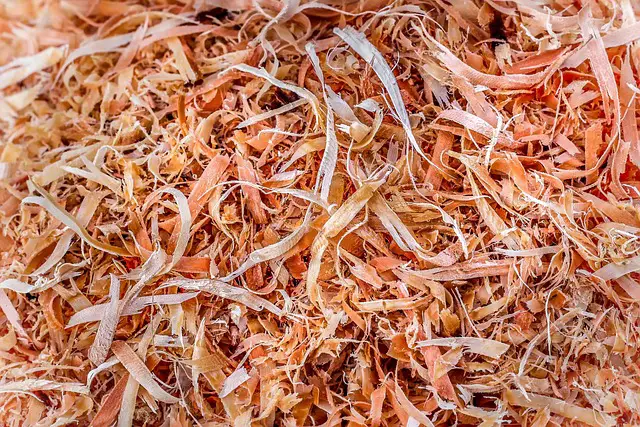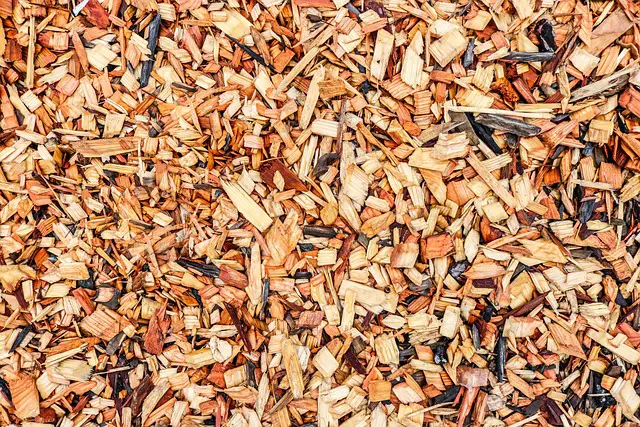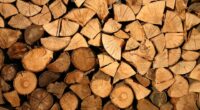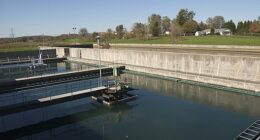Wood chips are larger, coarser pieces of wood often used for landscaping and erosion control, while mulch is finer and used for moisture retention and weed suppression.
TL;DR Wood chips Vs. Mulch
Wood chips also break down slowly over time, adding organic matter to the soil as they decompose.
Mulch refers to a variety of materials such as bark, leaves, straw, or compost that is used to cover the soil surface. Mulch helps regulate soil temperature, prevent weed growth by blocking sunlight, conserve moisture by reducing evaporation rates, and improve overall soil health.
What are Wood Chips?

Wood chips are exactly what they sound like – small pieces of wood that have been shredded or chipped. They can come from a variety of sources, including branches, logs, and discarded lumber. The size and shape of wood chips can vary depending on the method used to create them.
One common use for wood chips is as a mulch in gardening and landscaping. When spread around plants and trees, they help retain moisture in the soil by reducing evaporation. Wood chips also act as an insulating layer, protecting plant roots from extreme temperatures. Additionally, they suppress weed growth by blocking sunlight from reaching weed seeds.
In terms of appearance, wood chips add a natural aesthetic to outdoor spaces. They can be used to create defined pathways or borders within gardens, enhancing the overall visual appeal.
When it comes to sustainability, using wood chips derived from renewable sources such as tree trimmings or recycled materials is an eco-friendly option. This allows for responsible waste management while benefiting your garden at the same time.
What is Mulch?
Mulch is a material that is used to cover the soil surface around plants and trees. It can be made from various materials, including wood chips, leaves, straw, grass clippings, and even rubber. The main purpose of mulch is to protect the soil and plants by conserving moisture, suppressing weeds, regulating temperature fluctuations, and preventing erosion.
One of the key benefits of mulch is its ability to retain moisture in the soil. By acting as a barrier between the sun’s rays and the soil surface, it helps reduce water evaporation. This means less frequent watering for gardeners! Additionally, mulch also helps regulate soil temperature by keeping it cool during hot summer days and insulating it during cold winter nights.
Another advantage of using mulch is its weed-suppressing properties. By creating a physical barrier over the soil surface, mulch inhibits weed growth by blocking sunlight from reaching weed seeds. This reduces competition for nutrients and resources among plants.
Furthermore, organic mulches such as wood chips or compost slowly break down over time and enrich the soil with valuable nutrients while improving its structure. As they decompose, these organic materials release essential elements like nitrogen into the surrounding soil.
Mulching has numerous benefits for both gardeners and their plants alike.
It not only improves plant health but also saves time on watering,deters weeds,and promotes healthy microbial activity in your garden beds.
Wood chips Vs. Mulch – Key differences
| Aspect | Wood Chips | Mulch |
|---|---|---|
| Size and Texture | Larger, coarser, and chunkier wood pieces. | Finer, shredded or ground wood or organic material. |
| Composition | Typically made from wood logs or branches. | Can be made from various materials, including wood, bark, leaves, straw, or compost. |
| Use | Mainly used for landscaping, erosion control, and as a decorative ground cover. | Primarily used for moisture retention, weed suppression, and enhancing soil health. |
| Aesthetic Appeal | Often chosen for a more natural and rustic appearance in landscaping. | Selected for a neat and polished look, enhancing the appearance of flower beds and garden areas. |
| Decomposition Rate | Slower decomposition due to larger particle size. | Faster decomposition, as finer particles break down more quickly. |
| Soil Improvement | Less effective at improving soil quality due to slower decomposition. | Can enrich the soil with organic matter as it breaks down. |
| Weed Control | Provides some weed suppression but is not as effective as mulch. | Effective at preventing weed growth due to a denser layer. |
| Moisture Retention | Offers some moisture retention capabilities. | Effective at retaining soil moisture and reducing water evaporation. |
| Insulation | Offers limited insulation for plant roots in extreme weather conditions. | Provides better insulation and protection for plants against temperature fluctuations. |
Uses and Benefits of Wood Chips
Wood chips have a wide range of uses and benefits in various applications, including landscaping, gardening, and beyond. Here are some of the primary uses and benefits of wood chips:
Landscaping:
- Mulching: Wood chips can be used as mulch to cover the soil in garden beds, around trees, and shrubs. Mulch helps retain soil moisture, control weeds, and regulate soil temperature.
- Erosion Control: Wood chips can be spread on slopes or areas prone to erosion to stabilize the soil and prevent the loss of topsoil during heavy rains.
Playground Surfaces:
Wood chips are commonly used as a soft and impact-absorbing surface material in children’s playgrounds to enhance safety and reduce injuries from falls.
Pathways and Walkways:
Wood chips can be used to create natural-looking and permeable pathways in gardens, parks, and recreational areas.
Uses and Benefits of Mulch
Mulch serves various purposes in landscaping and gardening and offers several benefits. Here are the primary uses and benefits of mulch:
Weed Suppression
Mulch creates a physical barrier that helps prevent weeds from taking root and competing with desirable plants for nutrients and space.
Moisture Retention
Mulch reduces water evaporation from the soil, helping to maintain consistent soil moisture levels and reducing the need for frequent watering.
Soil Temperature Regulation
Mulch acts as insulation, protecting the soil from temperature extremes. It keeps the soil cooler in summer and warmer in winter, promoting healthier plant growth.
Image Credits
Featured Image By – Olya Adamovich from Pixabay








